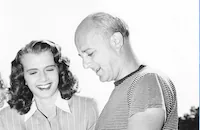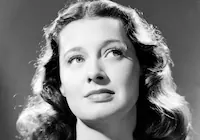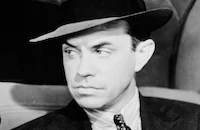Davy Crockett, Indian Scout
Brief Synopsis
Cast & Crew
Lew Landers
George Montgomery
Ellen Drew
Philip Reed
Noah Beery Jr.
Paul Guilfoyle
Film Details
Technical Specs

Synopsis
In 1848, after an Army platoon escorting a wagon train of homesteaders to a fort is attacked, Col. Pollard holds an informal hearing in his office. When Pollard reveals his suspicion that a spy has been operating in their midst, an angry homesteader named Mr. Simms accuses Red Hawk, an Indian guide, of being the spy. This prompts Red Hawk's partner, an Army scout named Davy Crockett, who shares his famous uncle's name, to give the following testimony: During the long journey to the fort, Davy and Red Hawk learn about the threat of a local Indian uprising. After they rescue a lone wagon from some braves, Davy and Red Hawk meet passenger Frances Oatman, who is part Kiowa Indian. Frances says that she hired her supposedly deaf-mute driver, Ben, for the journey west in search of a teaching job, and Davy encourages her to join the wagon train. One night, at the homesteaders' camp, Red Hawk learns that an attack is imminent, so he and Davy inform Capt. Weightman. Just then, a messenger arrives with news that braves from other tribes are gathering in preparation for battle. Inside his tent at the camp, Weightman is assured by the spy, an Indian chief named Lone Eagle who is posing as Weightman's trusted Indian agent, that a general uprising is unlikely. Suspicious of Frances, Red Hawk sneaks into her wagon and learns that she attended a missionary school for Indians. Later, Davy overhears Ben speaking to an Indian stable hand and realizes that Frances lied about him. The next morning, Davy, Red Hawk and the cavalry ride out with the wagon train, followed by Lone Eagle and the Indian stable hand. Davy, who has purposely left their route undecided, refuses to say which of two mountain passes they will take. When the road forks, Davy picks the dry South Pass, knowing that the camp will be warned that there will be no water for the next leg of the journey. Davy then instructs Red Hawk to follow anyone who leaves the camp. Once everyone is asleep, Davy captures Ben trying to sneak away and learns that he is spying for Lone Eagle. Meanwhile, Red Hawk follows Frances when she tries to slip away from the camp to warn her father, Lone Eagle. The next morning, Lone Eagle sends braves from several tribes to ambush the wagon train at South Pass. When Frances overhears her father vowing to kill women and children, she decides to return to warn Davy and Red Hawk of the attack, but they refuse to believe her until a messenger arrives with the same warning. Later, while returning with news of the altered route, a messenger is shot, and the message intercepted. Lone Eagle then quickly moves his braves to the new location. Marching well ahead of the homesteaders, the cavalry enters the pass, and the Indians use explosives to cause an avalanche, which cuts off the cavalry from the homesteaders. In order to get back to where the homesteaders are being attacked by braves, Davy uses a wagon full of explosives to blast a hole through the side of the avalanche. After they are rescued, the homesteaders are escorted safely to the fort, where Pollard decides to dismiss the charges against Frances and hire her as the fort's teacher.

Director

Lew Landers
Cast

George Montgomery

Ellen Drew

Philip Reed
Noah Beery Jr.

Paul Guilfoyle

Addison Richards

Robert Barrat
Erik Rolf
William Wilkerson

John Hamilton
Vera Marshe
Jimmy Moss
Chief Thundercloud
Kenneth Duncan

Ray Teal
Crew
Ford Beebe
Howard Bristol
Don Cash
Kenneth Crane
George Diskant
Elmer Ellsworth
Stuart Frye
Harold Knox
Edward Lambert
John Mescall
L. J. Meyers
Martin Obzina
Paul Sawtell
Richard Schayer
Bernard Small
Edward Small
C. I. Steenson
Rudolph Sternad
Grant Whytock

Film Details
Technical Specs

Articles
Davy Crockett, Indian Scout
The picture opens with a thuddingly literal narration setting up the time and circumstance; we are told "in 1848, the United States and Mexico signed a peace treaty that opened up the great Southwest to the wagons of the Pioneers, but when they came to occupy it, they found a lot of other early Americans who didn't know or care about our deal with Mexico. They had the idea it was their country." A wagon train with an Army escort is attacked by Indians, incurring many losses. Once the party reaches Fort Gardner, Col. Pollard (John Hamilton) convenes a hearing he suspects that a spy within the party tipped off Tribal Chiefs to the movements of the wagons. Mr. Simms (Erik Rolf) leaps ups during the hearing to accuse Red Hawk (Phillip Reed), a Cherokee. Army scout Davy Crockett (George Montgomery) vouches for Red Hawk and explains that it was he who arranged a meeting with Sleeping Fox (Chief Thundercloud), who told Crockett of the tribes' intent to wage war on the settlers. In flashback, Davy and Red Hawk rescue a lone wagon from an attack. The wagon is occupied by Frances Oatman (Ellen Drew), a schoolteacher from St. Louis, and her driver, a deaf mute named Ben (Paul Guilfoyle). Oatman joins with the wagon train that is attacked. Later, Crockett accompanies the wagon train through a mountain pass, but keeps the exact route secret in an effort to have the spy reveal themselves during the trek.
Davy Crockett, Indian Scout was made at a time when movie westerns were starting to reveal some sympathy for the plight of the Native Americans who clashed with settlers over treaties that are constantly broken. Delmer Daves' Broken Arrow and Anthony Mann's Devil's Doorway (both also from 1950) were certainly more nuanced and subtle in their treatment of the issue; the dialogue from Davy Crockett, Indian Scout is clunky and obvious (the screenplay is by Richard Schayer from a story by Ford Beebe), but the intent is clear in this campfire scene featuring the two leads:
Davy: I wonder why it can't always be peaceful like this. There's a powerful lot of land in this country enough for everybody, Indians and the Whites alike, if they'd only portion it out.
Frances: That's been tried by treaties. Settlers always move into the Indian's lands.
Davy: Yeah, I aim to do sumpthin' about that someday. I'd like to go to Washington like my uncle did the famous Davy Crockett.
Some of the exciting and well-staged scenes of wagon trains braving the narrow mountain passage and doing battle with Indians were "borrowed" from an earlier Edward Small/ United Artists feature, the superior Kit Carson (1940), directed by George B. Seitz.
Reviews of Davy Crockett, Indian Scout were blunt and not very positive. Writing in the New York Times, Bosley Crowther noted that the film had two distinctions: "There's nary a cowboy in sight and its hero is not the Davy Crockett of Alamo fame. He's only the famous frontiersman's cousin (sic)....As played by George Montgomery, he's a gent who recognizes that there are good and bad Indians and even saves his sidekick, Red Hawk, and Frances, that brave's girl friend, from the Army's wrath. In between there's lots of fireworks and little logic." In The Rotarian, Jane Lockhart wrote that the movie's "good cast [is] wasted on a film so filled with clichés [and] fantastic heroic exploits by unerring scouts as to be almost a burlesque of movie westerns."
The title of Davy Crockett, Indian Scout was shortened to just Indian Scout in its early airings on television, no doubt in a respectful nod to the popular Disney series, and perhaps in a bid to rectify the misleading nature of the original moniker.
Producer: Edward Small
Director: Lew Landers
Screenplay: Richard Schayer; Ford Beebe (story)
Cinematography: George Diskant, John Mescall
Art Direction: Martin Obzina, Rudolph Sternad
Music: Paul Sawtell
Film Editing: Kenneth Crane, Stewart Frye
Cast: George Montgomery (Davy Crockett), Ellen Drew (Frances Oatman), Phillip Reed (Red Hawk), Noah Beery, Jr. (Tex McGee), Paul Guilfoyle (Ben), Addison Richards (Capt. Weightman), Robert Barrat (James Lone Eagle), Erik Rolf (Mr. Simms), William Wilkerson (High Tree), John Hamilton (Col. Pollard)
BW-71m.
By John M. Miller

Davy Crockett, Indian Scout
Ellen Drew, 1914-2003
She was born Esther Loretta "Terry" Ray on November 23, 1914, in Kansas City, Missouri. The daughter of a barber, her family moved to Chicago when she was still an infant and she lived a very quiet childhood far removed from the glamour of Hollywood. She was encouraged by some friends to enter a beauty contest when she was just 17. After winning, she tried her luck in Hollywood, but found that they were no immediate offers for her particular talents.
She eventually took a waitressing job at C.C. Brown's, a famed Hollywood Boulevard soda fountain, and had virtually abandoned her dreams as a starlet when William Demarest, a popular actor's agent and well-known character actor, spotted her. Demarest arranged a screen test for her at Paramount, and she was promptly placed under contract for $50 a week.
For the first few years, (1936-38), Drew got only bit parts, and was often uncredited. When she finally got prominent billing in the Bing Crosby musical Sing You Sinners (1938), she decided to change her name, from Terry Ray to Ellen Drew. She earned her first major role in Frank Lloyd's If I Were King (1938) opposite Ronald Colman, yet for the most part of her career, rarely rose above "B" material and second leads. Still, she had some fine exceptions: Preston Sturges' enchanting comedy Christmas in July (1940), with Dick Powell; Tay Garnett's lighthearted war romp My Favorite Spy (1942) co-starring Kay Kyser; Julien Duvivier's taut The Imposter (1944), holding her own with a brooding Jean Gabin; and Mark Robson's chilling low-budget chiller Isle of the Dead (1945) opposite Boris Karloff. Drew made some notable television appearances in the late '50s including Perry Mason and The Barbara Stanwyck Show, before retiring from the entertainment industry. She is survived by her son David; five grandchildren; and five great-grandchildren.
by Michael T. Toole
Ellen Drew, 1914-2003
Quotes
Trivia
Notes
The television release title of this film was Indian Scout. A modern source notes that the film contains footage from United Artists' 1940 release Kit Carson (see AFI Catalog of Feature Films, 1931-40; F3.2313).
Born in 1786 in Tennessee, American frontiersman and politician Davy Crockett distinguished himself in Andrew Jackson's campaign against the Creek Indians. In 1821, Crockett was elected to the Tennessee state legislature, and in 1827, to Congress. He died in 1836 fighting for Texas at the Alamo. His character was featured in several films, beginning in 1908 with Davy Crockett in Hearts Divided. Subsequent pictures include Paramount's Davy Crockett, released in 1916, and Sunset's Davy Crockett at the Fall of the Alamo, released in 1926. The Walt Disney Studio produced two pictures dealing with Crockett's character, Davy Crockett, King of the Wild Frontier, released in 1955, and Davy Crockett and the River Pirates, released in 1956. Several television productions featuring the character were broadcast during the 1950s.

Miscellaneous Notes
Released in United States Winter January 6, 1950
Released in United States Winter January 6, 1950













